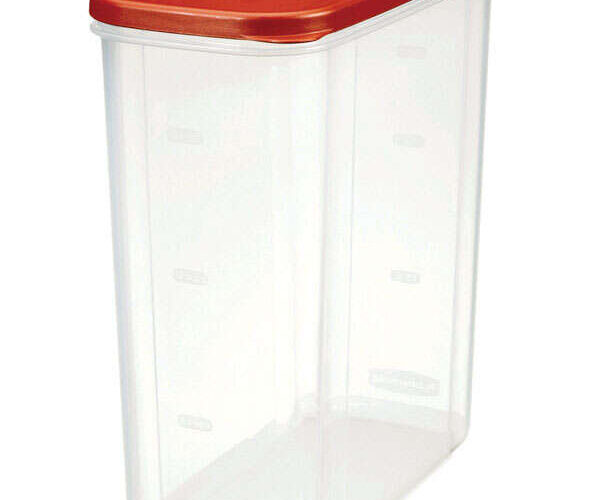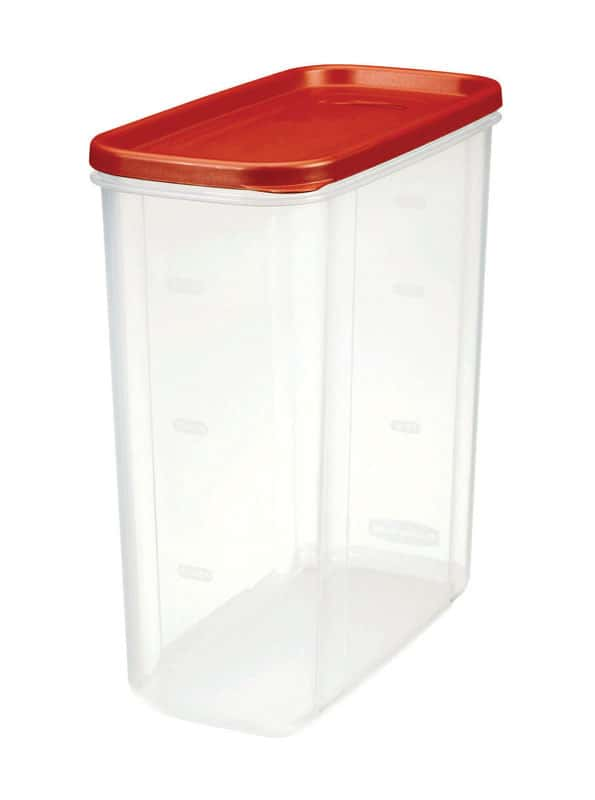RE: Vacuum sealing your unused filament
It would seem after reading though this thread, that you didn't follow the advice of the users who posted here, and instead went with some method of your own. perhaps you should work through this and let others know what you discovered.
RE: Vacuum sealing your unused filament
Rubbermaid 21 cups Clear/Red Food Storage Container 1 pk Item #6192892| Mfr #1776473
Reusable for all of eternity. Toss in a few desiccant packs, also reusable, and call it a day. Works great.
Don’t trust forum advice.
RE: Vacuum sealing your unused filament
Don’t trust forum advice.
RE: Vacuum sealing your unused filament
Rubbermaid 21 cups Clear/Red Food Storage Container 1 pk Item #6192892| Mfr #1776473
Reusable for all of eternity. Toss in a few desiccant packs, also reusable, and call it a day. Works great.
Drawing a vacuum on that would totally crush it. I use a chamber vac, and have crushed coffee cans (opened) and large, heavy spice containers.
RE: Vacuum sealing your unused filament
It would seem after reading though this thread, that you didn't follow the advice of the users who posted here, and instead went with some method of your own. perhaps you should work through this and let others know what you discovered.
I read through and saw that resealable versions could work, if used properly. After my recent results, and some more research I have found that many people have experienced the same thing with plain plastic and all migrate moisture after some time. In my case it happened to be 2 months without vacuum loss.
The recommendation I have found is to use Mylar bags. I may try this, but have not yet found a vacuum-able resealable version. I often switch back and forth between colours/types of filament, rarely doing the same print with the same back to back, so prefer a solution which is not using a seal bar, but rather a valve.
RE: Vacuum sealing your unused filament
I was looking at the product and thinking two things, 1. that maybe the strips that came with the bags are not giving a reliable read, and 2. maybe the desiccate packs you have are already spent and either need drying or just need new.
I use a Printdry system also, I suggest the color changing desiccate, for storage and its reusable. I have never had much luck with resealable bags, I only use then in the short term, admittedly I have not tried anything like the ones you showed but I vacuum seal my unused filament and it keeps for a long time.
RE: Vacuum sealing your unused filament
I suspect the strips are reading correctly. I am using the colour desiccants and they have changed from fresh to spent.
I am going to do some testing to see, using other bags (including the resealable that prusament provides).
RE: Vacuum sealing your unused filament
I live on the water 50 yards from it,average humidity outside from 30 to 50% depending on time of year, and I use a vacuum sealer without these issues that you describe, I dry my filament and desiccate in a print dry system, without these issues. I add a large satchel of desiccate into the bag before vacuum sealing it. and frankly I have some that have been sealed for years 4 + that have had no issues at all.
I'm not trying to one up you or make you feel bad. I'm offering my experience so that maybe it will help you grow. once again I have zero experience with the vacuum system your using but I rarly get more then two or there weeks out of a resealable bag with a desiccate pack in it.
P.s. I do understand about the difference between a mylar bag and a clear plastic bag, via reading on the internet. While I have not found any mylar bags for consumer use with my FoodSaver system, I have also not experienced the problems noted by others with the clear bags. I can only suggest giving them a try as I have had nothing but positive experiences with them over the years.
RE: Vacuum sealing your unused filament
They both function quite well, but I believe the food saver method to be the more economical one. I'll test it out with some filament that I won't be using for a while.
RE: Vacuum sealing your unused filament
I think the mylar bags may be more effective. That's what people who want to preserve food for 30 years use. Apparently even sealed plastic lets in too much in that scenario. One of the youtubers did some tests where even simply keeping filament in its original plastic bag with the original dessicant wasn't good enough. He got better results after drying out the filament with a filament dryer, even though he had just then opened the package. Wow. Who knew?
RE:
I just found some mylar bags which are 1. large enough and 2. resealable with the ziplock style seal. I just dried and sealed 2 spools with print-dry and sealed with refreshed desiccant. I will provide an update in a few months on their effectiveness. Here were the Mylar bags I found. Will convert to them as I use filament.
https://www.amazon.com/dp/B08MDQ29HY?psc=1&ref=ppx_yo2ov_dt_b_product_details
RE: Vacuum sealing your unused filament
I have mainly Prusament PLA filament at the moment. Most of them are still sealed and haven't been opened yet. The ones I do open I just place back into the bag they came in along with the desiccant it came with (ziplock sytle) and seal it closed leaving only a few cm gap. I then manually suck as much air out of it as possible, and quickly seal the bag closed!
Seems to keep a good seal and haven't had any issues! lol Will look at the vacuum pump method though - for longer term storage it would be better....
RE: Vacuum sealing your unused filament
Reporting back: what I've discovered is that a foodsaver is the wrong tool for long term filamet storage. A better choice is a sealed mylar bag--the thicker the mylar the better. Why? This is how it is done when you want to store emergency rations (freeze dried food) for 25-30 years and not have it go bad. I'm not saying you'd want to store your filament for that long, but the same principle applies: moisture will migrate through plastic bags, and apparently simply packing it with desiccant is still not enough added protection.
How did I discover this? I have a number of sunlu PETG rolls that were never opened but that had been sitting on the shelf for a couple of years. When I recently opened them, they printed terribly, due to moisture absorption. Go figure.
RE: Vacuum sealing your unused filament
What device are you using to extract the air?
Reporting back: what I've discovered is that a foodsaver is the wrong tool for long term filamet storage. A better choice is a sealed mylar bag--the thicker the mylar the better. Why? This is how it is done when you want to store emergency rations (freeze dried food) for 25-30 years and not have it go bad. I'm not saying you'd want to store your filament for that long, but the same principle applies: moisture will migrate through plastic bags, and apparently simply packing it with desiccant is still not enough added protection.
How did I discover this? I have a number of sunlu PETG rolls that were never opened but that had been sitting on the shelf for a couple of years. When I recently opened them, they printed terribly, due to moisture absorption. Go figure.
i3 Mk3 [aug 2018] upgrade>>> i3MK3/S+[Dec 2023]
RE: Vacuum sealing your unused filament
I should have expressed my question after doing some research. Are the Mylar bags re-sealable or you heat sealing?
i3 Mk3 [aug 2018] upgrade>>> i3MK3/S+[Dec 2023]
RE: Vacuum sealing your unused filament
You can certainly buy re-sealable "zip-lock" type of mylar bags, but again since the re-sealable seam is plastic, it's a weak point. That is why I reference emergency rations storage procedures as the guide: heat sealing is superior. If you want to be extra sure, you can double or triple heat seal. It takes only seconds. That's multiple orders of magnitude faster than waiting for a spool to dehydrate on a filament dryer.
RE: Vacuum sealing your unused filament
With vacuum we save space.

